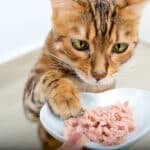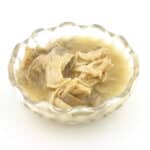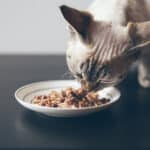Are you a cat lover looking for a healthier, more affordable food option for your feline friend? Making homemade chicken cat food could be the answer.
First, let’s take a look at why it’s important to consider a homemade cat food diet. Many commercial cat foods contain fillers, preservatives and other ingredients that can be detrimental to your cat’s health. A homemade chicken cat food diet, on the other hand, is made with fresh ingredients and can be tailored to your cat’s needs.
Another benefit to making homemade cat food is that you know exactly what is going into your pet’s diet. You can make sure that your cat is getting the proper nutrition and avoid any potentially harmful ingredients.
Finally, making your own homemade chicken cat food can be economical. The cost of the ingredients is much lower than buying pre-made cat food.
But why choose chicken? Well, as you probably already know, chicken is affordable and easy to prepare in bulk. You can get several pounds of chicken breast from your local supermarket for relatively cheap and cook it all at once in the oven.
In this blog, we’ll explore the basics of making homemade chicken cat food. We’ll discuss the benefits, ingredients, and safety considerations. Whether you’re a novice or an experienced home chef, you’ll find the information you need to get started. So, let’s get cooking!
Table of Contents
- 1. Chicken & Tuna
- 2. Chicken & Mackerel
- 3. Chicken and Rice
- 4. Chicken and Oatmeal
- 5. Raw Chicken Thighs
- Taurine: Supplements for your Homemade Chicken Cat Food
- Chicken Quality for Homemade Chicken Cat Food
- Other Ingredients You can Add to These Recipes
- Cooking Chicken in Bulk
- FAQs : Homemade Chicken Cat Food
1. Chicken & Tuna
If you’re looking for a nutritious, delicious meal for your feline friend, look no further than this Chicken & Tuna Recipe! This recipe is easy to make and can be tailored to your cat’s specific dietary needs. It’s a great way to provide your cat with a balanced meal and is easy on the budget. Plus, most cats love both chicken and tuna, so it’s an easy win in our books.

Chicken & Tuna Recipe
Equipment
- 1 Blender or food processor
- 1 Storage container
Ingredients
- 1 cup chicken breast cooked
- 1 can tuna
- 2 servings taurine cat supplement
Instructions
- Combine all three ingredients in your blender or food processor.
- Blend until the mixture is the desired texture. More blending will make more of a pate, while less blending will keep it chunky.
- Serve to your cat about 1/2 cup of mixture per meal. Store leftovers in the refrigerator for up to three days or the freezer for up to three weeks.
2. Chicken & Mackerel
Are you looking for a healthy, nutritious meal for your cat? If so, then consider chicken and mackerel. Both meat sources are packed with essential nutrients and can be a great addition to your pet’s diet. Mackerel is especially high in Omega-3 fatty acids, which are beneficial for cats. Omega-3s help to maintain healthy skin and coat, as well as aid in joint health. Both chicken and mackerel are high in protein, which is essential for cats to maintain muscle mass, healthy skin, and fur. Protein also helps to keep your pet’s energy levels up and is important for their overall health.
Chicken & Mackerel
Equipment
- 1 Blender or food processor
- 1 Storage container
Ingredients
- 1 cup chicken breast cooked
- 1 can mackerel
- 2 servings taurine cat supplement
Instructions
- Combine all three ingredients in your blender or food processor.
- Blend until the mixture is the desired texture. More blending will make more of a pate, while less blending will keep it chunky.
- Serve to your cat about 1/2 cup of mixture per meal. Store leftovers in the refrigerator for up to three days or the freezer for up to three weeks.
3. Chicken and Rice
If you’re looking for an easy and healthy way to give your cat a nutritious meal, chicken and rice is the perfect choice. This simple, yet tasty dish is packed with important proteins, vitamins, and minerals that will keep your pet healthy and happy. Plus, it’s a great way to use up leftovers from dinner!

Chicken and Rice Recipe
Ingredients
- 1/4 cup chicken breast cooked
- 1/2 cup long-grain brown rice cooked
- 1/2 ounce canned clams chopped, in juice
- 1 serving taurine cat supplement
Instructions
- Chop chicken into cat-bite-sized pieces
- Mix together all ingredients
- Serve immediately
Notes
4. Chicken and Oatmeal
If you’re looking for a delicious but also healthy meal for your cat, why not try this Chicken and Oatmeal recipe? It’s packed with nutrition, filled with flavor, and your cat will love it. Not only is it a great way to get your pet the nutrition it needs, but it’s also a great way to save money on expensive cat food.
Oatmeal is a great carbohydrate choice for cats because they can digest it more easily than other carbohydrates. Plus, it’s packed full of energy, making it a good choice for young, pregnant or active cats.
Chicken and Oatmeal Recipe
Ingredients
- 1/4 cup chicken breast cooked
- 1/2 cup oatmeal cooked
- 1 serving taurine cat supplement
Instructions
- Chop chicken into cat-bite-sized pieces
- Mix together all ingredients
- Serve immediately
5. Raw Chicken Thighs
If you’re looking for a nutritious and delicious meal for your cat, look no further than a Raw Chicken Thighs recipe! Not only is it packed with essential nutrients that cats need, but it also offers a rich and savory flavor cats will love.
The key to making this recipe is to use fresh, raw chicken thighs. This part of the chicken is typically considered to be a healthier option than other parts, as it’s higher in protein and lower in fat. It also contains other essential nutrients such as zinc, magnesium, iron, and B vitamins.
Also keep in mind that when using any type of raw chicken it must be of the highest quality. Free-range, organic with no antibiotics or hormones is a must. With this recipe you’ll be spending a little more, but providing your cat with the most nutritious meal possible.

Raw Chicken Thighs Recipe
Equipment
- 1 Meat Grinder optional
Ingredients
- 5 lbs chicken thighs with bone
- 1 cup water
- 4 raw egg yolks
- 6 servings taurine cat supplement
Instructions
- Remove the skin from half the chicken thighs, but do not remove the fat.
- Remove the bone from 1/4 of the chicken thighs and rinse the meat with water.
- Whisk the egg yolks and water in a separate bowl.
- Chop the thigh meat into sizes that will fit in the meat grinder.
- Feed the meat through the meat grinder and collect in a bowl.
- Add the taurine and egg mixture to the bowl and mix well.
- Portion out and freeze the excess.
Notes
Taurine: Supplements for your Homemade Chicken Cat Food
As you’ve probably noticed by now, all of these recipes call for supplementing your homemade chicken cat food with taurine. This is because cats tend to have a difficult time getting enough taurine in their diet. Most commercial cat foods, in fact, are supplemented with taurine.
Taurine is an amino acid that’s essential for cats, but they’re unable to produce it on their own. It’s found in high quantities in animal-based proteins, like chicken, and helps with eye and heart health, as well as digestion. Adding taurine to your chicken cat food can help make sure your cat is getting enough of this important nutrient. If your cat does not get enough taurine in their diet they could be at risk for developing severe health issues such as feline taurine retinopathy.
When making your own cat food at home, you can add taurine in two ways. The first is to purchase taurine supplements from your local pet store and add it to the food. Make sure you follow the instructions on the package, as it’s important to get the dosage right. One dose (listed in the recipes) is going to be equal to one daily dose in your taurine supplement.
The second way is to use a taurine-rich ingredient, such as chicken hearts or livers. These are packed with taurine and can be added to the food to ensure your cat is getting enough of this important nutrient.
We recommend just adding taurine as a supplement as it’s easier to ensure your cat is getting enough.
Chicken Quality for Homemade Chicken Cat Food
When it comes to selecting chicken for homemade cat food, there are several factors to consider. First, you should make sure the chicken is fresh. Fresh chicken should be free of any signs of spoilage, such as discoloration or a sour smell. If the chicken appears to be spoiled, it should be discarded.
The next step is to determine the quality of the chicken. Generally speaking, the higher the quality of the chicken, the better the nutrition it will provide for your cat. Look for chicken that is organic and free-range, as these types of chicken tend to have the highest quality. Also, make sure the chicken is free of preservatives, antibiotics, hormones, and other additives.
You can go with the cheaper chicken options if you’d like (that’s why a lot of owners choose chicken as an ingredient, after all), just know that these will be more likely to contain antibiotics, hormones, bacteria and parasites. If you do go this route, it’s very important that you thoroughly cook the chicken first, preferably baked in the oven. It’s also worth noting that even the cheaper, lower quality chicken options at the grocery store are still probably higher quality than most commercial cat foods.
Finally, it’s important to ensure the chicken is safe to feed to your cat. Check to make sure it has been cooked thoroughly and is free of bones, skin, and other inedible parts. If the chicken has been frozen, make sure it is defrosted properly before serving.
Other Ingredients You can Add to These Recipes
One of the benefits of these recipes is they’re fairly easy to modify to suit your cat’s needs. Add or swap out ingredients to mix up the flavor so your cat doesn’t get bored of their meals. Mixing it up also ensures your cat is getting a well-rounded diet.
Here are some ingredients you can add to homemade chicken cat food to make it even more special for your kitty:
- Eggs: Eggs are an excellent source of protein for cats, and they can be scrambled or boiled and added to your homemade chicken cat food recipe.
- Vegetables: Adding vegetables to your cat’s diet can provide important vitamins and minerals, so consider adding some cooked and pureed vegetables to the mix.
- Fish: Fish is a great source of omega-3 fatty acids and is a tasty addition to homemade cat food recipes. Try adding some canned tuna or salmon to the mix.
- Liver: Liver is a great source of iron, zinc, and vitamin A, so consider adding a small amount of cooked and pureed liver to your homemade cat food.
Making homemade cat food is a great way to provide your cat with a variety of nutritious ingredients that can help keep them healthy. With the right ingredients, you can make delicious and nutritious cat food that your kitty is sure to love.
Cooking Chicken in Bulk
One of the main benefits of homemade chicken cat recipes is how easy it is to cook chicken. Not only can you buy chicken in bulk, but you can cook it in bulk and freeze it for later use.
Here are some of the easiest ways to cook chicken in bulk.
1. Oven Roasting: Oven roasting is a great way to quickly and easily cook large amounts of chicken. Simply preheat your oven to 375 degrees Fahrenheit and place your chicken on a baking sheet. Drizzle with minimal amounts of oil. Bake for 25-35 minutes, or until the internal temperature of the chicken reaches 165 degrees Fahrenheit.
2. Slow Cooker: Slow cookers are great for cooking large amounts of chicken. Place your chicken in the slow cooker and cover with a liquid such as chicken broth. Cook on low for 6-8 hours.
3. Instant Pot: The Instant Pot is a great way to quickly cook large amounts of chicken. Simply place your chicken in the Instant Pot and add a liquid such as chicken broth. Set the timer for 8 minutes and let the Instant Pot do the rest.
4. Grilling: Grilling is a great way to cook large amounts of chicken quickly and easily. Preheat your grill to medium heat and lightly oil the grates. Place your chicken on the grates and cook for 8-10 minutes per side, or until the internal temperature of the chicken reaches 165 degrees Fahrenheit.
No matter which method you choose, cooking chicken in bulk doesn’t have to be a difficult task. With a few simple techniques and recipes, you can quickly and easily cook large amounts of chicken.
FAQs : Homemade Chicken Cat Food
It is not recommended that cats eat chicken every day. While chicken is a good source of lean protein, it does not provide cats with all the essential vitamins and minerals they need for a balanced diet. Too much of anything is not a good idea, and chicken should only be given in moderation.
Cats should receive a variety of proteins from different sources, such as fish, eggs, and beef. This allows cats to get a range of essential nutrients for optimal health. Additionally, cats may develop food allergies if they are fed the same protein source every day.
When it comes to feeding cats chicken, it is best to consult with a veterinarian to determine an appropriate feeding schedule. Generally, cats should receive no more than one serving of chicken per day, and it should not be the only protein source in their diet. It is also important to ensure the chicken is cooked thoroughly before feeding it to your cat.
Homemade chicken cat food recipes can be a great way to give your cat a healthy and nutritious meal. The key to ensuring that your homemade cat food recipes are healthy is to make sure that they provide your cat with all the essential nutrients that they need. When creating your recipes, make sure to include lean proteins such as cooked chicken, fish, or turkey; carbohydrates such as oats, brown rice, and quinoa; and healthy fats such as olive oil, coconut oil, and fish oil. Additionally, adding a variety of vegetables and fruits can provide your cat with important vitamins and minerals.
When preparing your homemade cat food recipes, it is important to avoid adding any unhealthy ingredients such as processed meats, table scraps, or excessive salt and sugar. Additionally, be sure to cook all ingredients thoroughly to avoid any potential risks of food-borne illnesses. Finally, always consult with your veterinarian to ensure that the recipes you are feeding your cat are providing them with the proper nutrition.
If you’re feeding your cat homemade chicken cat food recipes, you may want to consider adding additional supplements to ensure that your cat is receiving a balanced and healthy diet. Cats require certain vitamins and minerals that are often not present in home-cooked meals. Additionally, homemade cat food may not provide the complete and balanced nutrition that commercially prepared cat foods provide.
Supplementing your cat’s diet with a multivitamin and mineral supplement can help ensure that your cat is getting all the nutrients it needs. These supplements can also provide beneficial vitamins and minerals that can help boost your cat’s immune system and overall health. Additionally, some supplements can help reduce hairballs and other digestive issues.
Additionally, read the label on the supplement to make sure it is designed for cats and not for dogs. Finally, be sure to follow the instructions on the label to ensure that you are providing your cat with the correct dosage.
When it comes to feeding your cat homemade chicken cat food recipes, there are a few concerns to be aware of.
First, it is important to be aware of the nutritional needs of your cat. While homemade cat food recipes may be more nutritious than store-bought cat food, they may not provide all of the essential nutrients that your cat needs. Talk to your veterinarian before beginning a homemade diet and make sure the recipes you use are nutritionally complete.
Second, it is important to use safe food preparation practices when handling raw chicken. Make sure to wash your hands, surfaces, and utensils thoroughly with hot, soapy water after handling the raw chicken.
Additionally, always cook the chicken thoroughly to ensure it is safe for your cat to consume. If you don’t cook the chicken, ensure it’s really high quality, organic chicken.
Finally, be aware of potential food allergens in your recipes. Many cats have allergies to certain ingredients and these can be easily overlooked in homemade recipes. If you notice any adverse reactions when feeding your cat homemade chicken cat food, discontinue use and consult your veterinarian.
Yes, you can feed your kitten homemade chicken cat food recipes, as long as they are nutritionally balanced and tailored to your kitten’s individual needs. When making homemade cat food, you should use only fresh, high-quality ingredients and follow a recipe developed by a veterinary nutritionist.
When making homemade chicken cat food, it is important to include all essential nutrients, such as protein, fat, carbohydrates, vitamins, minerals, and water. It is also important to ensure the food is properly cooked and not undercooked or overcooked.
It is best to avoid adding any additional ingredients such as onions, garlic, or grapes, as these can be toxic to cats. You should also avoid feeding your kitten raw eggs or raw meat, as these can contain harmful bacteria.
If you are concerned about your kitten’s nutrition, it is best to consult with your veterinarian before beginning to prepare homemade chicken cat food recipes. Your veterinarian can help you create a meal plan that meets your kitten’s individual needs and ensure the recipes you choose are balanced and healthy.
When it comes to making homemade cat food, one of the most important tools you’ll need is a meat grinder. The right meat grinder will help you grind up fresh, nutritious ingredients to make the food your cat loves. But with so many options on the market, how do you know which one is best for making cat food?
First, consider what type of power source you want. Manual grinders are often less expensive, but may require more effort to grind the meat. Electric grinders are great if you don’t want to exert a lot of energy, but they can be more expensive.
Next, think about the size of the grinder. If you plan on making large batches of cat food, you’ll want to opt for a larger grinder. But if you’re just making small batches, a smaller grinder will do the job.
Finally, consider the material of the grinder. Stainless steel grinders are more durable and will last longer, but they can be more expensive. Plastic grinders may be a more affordable choice, but they may not be as durable.
We recommend the Sunmile Electric Meat Grinder, which incorporates all these things.














